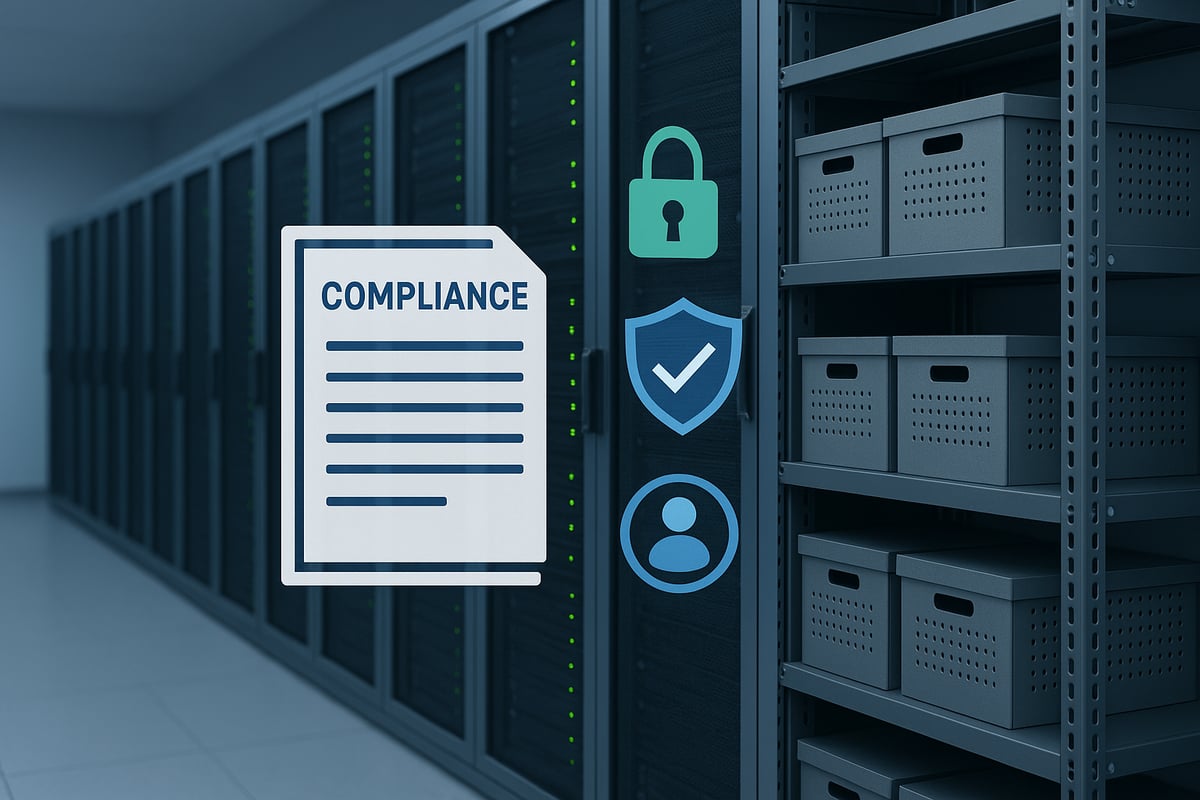Essential Guide to Data Security Storage in 2025
In 2025, data security storage is more critical than ever as cyber threats grow in sophistication and the amount of digital information skyrockets. Organizations face increased data breaches and regulatory fines, making secure storage a top priority.
This essential guide will help you navigate the evolving risks, understand key storage security principles, and adopt emerging technologies. You will discover compliance requirements and learn actionable strategies to protect your assets.
Stay ahead by mastering best practices that keep sensitive data safe, ensure compliance, and minimize costly incidents. Start implementing robust data security storage solutions today for a safer tomorrow.
Understanding Data Security Storage in 2025
In 2025, organizations face a rapidly changing landscape for data security storage. As digital assets multiply and threats evolve, understanding the fundamentals of protecting stored information is critical. This section explores what data security storage means today, examines current trends, and unpacks the core concepts every business must know.

Defining Data Security Storage
Data security storage refers to the comprehensive protection of digital assets while they reside within storage systems. This discipline blends storage technology, networking, and security practices to ensure sensitive data remains safe from unauthorized access and tampering.
The primary goals are confidentiality, integrity, and availability—commonly known as the CIA triad. Confidentiality ensures only authorized users can access data, integrity verifies information remains unaltered, and availability guarantees data is accessible when needed.
It is important to distinguish data security storage from general data protection. While both aim to safeguard information, data protection emphasizes backup, recovery, and prevention of data loss, whereas data security storage focuses on preventing breaches and maintaining trust in stored data.
Hybrid cloud environments present unique challenges for data security storage. Sensitive data now moves between on-premises, public, and private clouds, making unified oversight complex. In fact, over 60% of organizations store sensitive information in hybrid or multi-cloud settings, highlighting the need for specialized security strategies.
Current Landscape and Trends
The global data sphere is projected to reach 175 zettabytes by 2025, creating unprecedented demands on data security storage. Organizations now manage a mix of on-premises, cloud, edge, and hybrid storage, each with its own security challenges.
Cyber threats are becoming more sophisticated, with attackers targeting not just primary data but also backups and storage infrastructure. Regulatory requirements such as GDPR, CCPA, and HIPAA are driving organizations to strengthen their security measures and prove compliance. Meanwhile, artificial intelligence and machine learning are used by both defenders and attackers, intensifying the arms race in storage security.
Ransomware poses a specific risk, as attackers increasingly focus on backup systems to maximize disruption. In response, many organizations are shifting toward zero-trust storage architectures, which assume no user or device is inherently trusted. For a deeper look at these trends and how organizations can benchmark their security posture, see Storage and Data Protection Trends for 2025.
This evolving landscape requires a proactive approach to data security storage, with continuous adaptation to new threats and technologies.
Key Storage Security Concepts
Securing data security storage involves a combination of physical, technical, and administrative controls. Physical controls include secure facilities and restricted access to hardware. Technical controls range from encryption and access management to network segmentation. Administrative controls set policies and procedures for managing data.
Controls are also categorized as preventive (such as encryption and strong authentication), detective (like monitoring and logging), and corrective (including backups and disaster recovery). Effective risk management is essential—organizations must identify threats, assess vulnerabilities, treat risks, and routinely monitor their security posture.
Common threats to data security storage include unauthorized access, data leakage, malware infections, and improper decommissioning of storage media. The impact of these risks can be severe, ranging from data breaches and corruption to regulatory fines and loss of customer trust.
By understanding these core concepts, organizations can build resilient strategies that protect their most valuable digital assets.
Major Threats and Risks to Data Storage Security
Protecting data security storage in 2025 requires a deep understanding of evolving threats and the risks they pose. As organizations rely more on digital assets, vulnerabilities in storage systems can lead to significant losses, disruptions, and regulatory consequences. This section examines the most pressing dangers facing data security storage and how to address them.

Common Threats to Storage Systems
Data security storage environments face a wide array of threats targeting both digital and physical components. Unauthorized usage and access remain among the most frequent risks. Attackers may exploit weak credentials or misconfigured permissions to infiltrate storage infrastructure.
Other key threats include:
- Data breaches from accidental or malicious leaks of sensitive data
- Corruption, modification, or destruction of stored information
- Data leakage through unsecured endpoints or misconfigured cloud storage
- Theft or accidental loss of physical storage media, such as laptops or portable drives
- Malware and ransomware attacks that compromise storage arrays and backups
- Improper treatment or sanitization of storage devices after end-of-use
Each of these threats can undermine the confidentiality, integrity, or availability of data security storage. Organizations must remain vigilant, regularly assessing their environments for new risks.
Data Breaches: Types and Impact
Data breaches in data security storage environments can take several forms. Unauthorized access, disclosure, destruction, or alteration of sensitive records are all common scenarios. For instance, healthcare data leaks or the exposure of financial records can occur through misconfigured storage or compromised credentials.
The impact of a breach is far-reaching. Beyond the immediate cost of investigating and containing the incident, organizations may face mandatory notifications, litigation, and regulatory fines. Brand reputation can suffer from publicized breaches, resulting in lost customer trust.
According to industry projections, the average cost of a data breach is expected to exceed $5 million in 2025. Lesser-known incidents, such as accidental deletion or improper backup handling, also contribute to significant losses. These issues highlight why robust data security storage controls are essential for every organization.
|
Breach Type |
Example |
Potential Impact |
|---|---|---|
|
Unauthorized Access |
Hacked database |
Data theft, compliance violations |
|
Accidental Deletion |
Admin error |
Data loss, operational disruption |
|
Improper Backup Handling |
Lost backup tape |
Data exposure, recovery failure |
Storage Security Risk Management
Effective risk management is the cornerstone of data security storage. The process begins with a comprehensive risk assessment, identifying threats, vulnerabilities, and potential impacts on stored data. Preventive controls, such as encryption and access restrictions, are implemented to reduce risk exposure.
Detective controls like monitoring and logging help identify suspicious activity, while corrective measures such as reliable backups and recovery plans ensure resilience. Risk acceptance and communication are crucial, involving stakeholders in decisions about which risks to tolerate or mitigate.
Continuous monitoring and review enable organizations to adapt to evolving threats. For example, when migrating to cloud storage, a structured risk management process ensures that sensitive data remains protected throughout the transition. Compliance-driven risk management is also increasingly important, as regulations demand evidence of robust controls and ongoing oversight.
Collaboration across IT, legal, and compliance teams is critical. Many organizations are now leveraging resources such as digital protection strategies to align their data security storage approaches with industry best practices. According to a recent industry survey, 70% of organizations plan to increase investment in storage risk management in 2025, underscoring the growing recognition of its importance.
Essential Technologies and Best Practices for Securing Data Storage
Securing data security storage in 2025 demands a multi-layered approach, integrating advanced technologies with proven best practices. Organizations face evolving threats and rising compliance requirements, making it critical to adopt robust controls across the entire storage lifecycle. Let’s explore the essential building blocks that safeguard data in today’s complex environments.

Encryption and Key Management
Encryption remains a cornerstone of data security storage, ensuring that data, whether at rest or in transit, is unreadable to unauthorized users. Modern approaches include software-based encryption, hardware-based solutions, and self-encrypting drives, each offering unique benefits and deployment scenarios.
However, encryption is only as effective as its key management. Secure key generation, storage, and rotation are critical, as poor key management can lead to data loss or breaches. Separating encryption keys from storage systems is a best practice, minimizing insider threats and reducing attack surfaces.
Consider the following key management challenges:
- Secure key storage away from primary storage arrays
- Regular key rotation to limit exposure
- Controlled access to encryption keys
For a comprehensive overview of foundational measures that complement data security storage, review these information security best practices.
Access Controls and Authentication
Strong access controls are vital for data security storage, restricting who can interact with storage assets. Role-based access control (RBAC) helps assign permissions based on job roles, while multi-factor authentication (MFA) adds an extra layer of protection for administrative accounts.
Implementing the principle of least privilege ensures users and applications have only the access necessary for their tasks, reducing the risk of accidental or intentional misuse. Auditing and logging all access attempts to storage systems can provide early warning of suspicious activity and support forensic investigations.
Best practices include:
- Enforcing MFA for all privileged storage accounts
- Regularly reviewing and updating access permissions
- Monitoring logs for unauthorized access attempts
A single over-privileged account can compromise the entire data security storage environment, so diligent management is essential.
Data Integrity and Availability Measures
Maintaining the integrity and availability of data security storage is non-negotiable. Regular backups, redundancy through RAID, mirroring, or replication, and the use of immutable storage technologies like WORM (write-once-read-many) help protect against accidental deletion, corruption, or ransomware.
Data integrity checks, such as hashing and checksums, ensure data has not been tampered with or degraded. Error correction mechanisms further enhance reliability. Disaster recovery planning, including routine testing, prepares organizations to respond quickly and minimize downtime.
Key strategies for integrity and availability:
- Schedule frequent, automated backups
- Use geographically dispersed replication
- Employ immutable storage for critical data
Organizations that invest in these measures often recover from incidents with minimal data loss or disruption to operations.
Network and Perimeter Security for Storage
Data security storage is only as strong as the networks connecting it. Isolating storage networks from general IT traffic through network segmentation helps contain threats. Firewalls, VPNs, and secure protocols like TLS and IPsec protect data as it moves between endpoints and storage systems.
Continuous monitoring for anomalous network activity is crucial. Rapid detection of unauthorized access attempts or malware propagation can make the difference between a contained incident and a widespread breach.
Network security checklist:
- Implement strict firewall rules around storage subnets
- Enforce encrypted connections for all storage traffic
- Monitor for abnormal data transfer rates or connection attempts
Segmenting storage networks is a proven method to reduce the blast radius of any potential attack within the data security storage infrastructure.
Secure Decommissioning and Data Sanitization
Proper decommissioning of storage media is a critical, often overlooked element of data security storage. Simply deleting files or formatting disks does not guarantee data removal. Secure sanitization methods—cryptographic erasure, degaussing, or physical destruction—must be used to prevent data recovery.
Regulations often dictate specific sanitization standards, especially for industries handling sensitive or regulated data. Failure to comply can result in data breaches and significant penalties.
Sanitization methods:
- Cryptographic erasure for SSDs and encrypted drives
- Degaussing for magnetic media
- Physical destruction for end-of-life devices
A breach caused by improper disposal of storage devices can undermine the strongest security controls implemented during active use.
Security Monitoring and Incident Response
Continuous monitoring is a linchpin of data security storage. Automated alerts for suspicious activity enable rapid response, limiting the impact of potential incidents. Storage-specific incident response plans ensure teams act quickly and effectively when a threat is detected.
Key components:
- Real-time monitoring tools tailored to storage systems
- Automated alerting for unauthorized access or data exfiltration
- Predefined incident response workflows with regular testing
Organizations that invest in proactive monitoring and response can swiftly contain breaches and maintain trust in their data security storage operations.
Regulatory Compliance and Data Privacy in Storage Security
Organizations face mounting pressure to protect sensitive information as regulations around data security storage grow increasingly strict. New laws and evolving threats demand that companies address compliance and privacy from the ground up, integrating these priorities into every layer of their storage strategies.

Key Regulations Impacting Storage Security
Global regulations are reshaping the landscape of data security storage. Laws such as the General Data Protection Regulation (GDPR), California Consumer Privacy Act (CCPA), and the Health Insurance Portability and Accountability Act (HIPAA) set strict guidelines for how organizations must store, retain, and manage sensitive data. These laws require robust security controls, including encryption, access management, and regular auditing.
Data residency rules add another layer of complexity, mandating that certain types of information remain within specific geographic borders. Cross-border data transfers now require careful scrutiny to ensure legal compliance. For example, failing to secure cloud storage can lead to hefty fines, as regulators crack down on organizations that expose personal data through misconfigurations or insufficient controls.
A growing number of organizations are now adopting comprehensive digital asset management requirements to address these evolving legal standards. By aligning storage strategies with these regulations, companies can reduce risk, protect customer trust, and avoid costly penalties. The right approach to data security storage is no longer optional—it is a business imperative.
Privacy by Design in Storage Solutions
Privacy by design is essential for modern data security storage. This approach embeds privacy considerations into the architecture of storage solutions from the very beginning. Techniques such as data minimization limit the amount of personal information stored, while pseudonymization shields identities in the event of a breach.
Secure access controls and comprehensive audit trails ensure that only authorized users interact with sensitive data, and every action is traceable. For example, healthcare organizations deploy storage systems with built-in privacy controls to protect patient records, demonstrating compliance and accountability.
Proactive integration of privacy features makes it easier to meet regulatory requirements and respond quickly to audits. When storage infrastructure is designed with privacy as a core principle, organizations can confidently manage sensitive information and maintain public trust.
Meeting Compliance Through Storage Security Best Practices
Achieving compliance in data security storage requires a holistic approach. Organizations should:
- Document all security controls and maintain evidence for audits.
- Conduct regular compliance assessments and gap analyses.
- Foster collaboration between IT, legal, and compliance teams.
A recent statistic shows that 80% of organizations now cite compliance as a primary driver for investing in storage security. By staying proactive and maintaining clear documentation, companies can streamline audits and adapt quickly to changes in regulations.
Adopting these best practices ensures data security storage strategies remain robust, compliant, and future-ready.
Step-by-Step Guide to Building a Robust Data Security Storage Strategy in 2025
Building a robust data security storage strategy is essential for protecting your organization’s most valuable digital assets. By following these clear steps, you can ensure your storage infrastructure is resilient against evolving cyber threats in 2025.
Step 1: Assess Data and Storage Risks
Start by inventorying all data assets and mapping out every location where your data is stored. This includes on-premises servers, cloud platforms, and endpoint devices. Classify data by sensitivity and regulatory requirements.
Evaluate current controls protecting your data security storage, such as encryption and access management. Use a risk assessment template to identify gaps, especially in hybrid environments. Consider threats like unauthorized access, data leakage, and physical theft.
Engage stakeholders to understand business priorities and regulatory obligations. By systematically assessing risks, you lay the groundwork for a resilient data security storage strategy.
Step 2: Define Security Policies and Controls
Establish and document comprehensive security policies tailored for your data security storage needs. Define standards for access control, encryption, and backup frequency, ensuring they align with industry regulations and business objectives.
Policies should specify who can access various storage systems, how encryption keys are managed, and retention periods for different data types. For example, create a policy for managing storage access in remote work scenarios, emphasizing least privilege principles.
Regularly review and update these policies to address new risks and compliance changes. Clear, enforceable controls are the backbone of effective data security storage management.
Step 3: Implement Layered Security Technologies
Deploy multiple layers of defense to protect your data security storage infrastructure. Start with strong encryption for data at rest and in transit. Use hardware-based solutions where possible, and separate key management from storage systems.
Implement robust access controls, such as role-based access control (RBAC) and multi-factor authentication (MFA). Network segmentation and secure protocols like TLS or IPsec help isolate storage from general traffic and external threats.
Consider adopting a zero-trust approach, which continuously authenticates users and devices before granting access. For more on this, see how Zero-Trust Architecture Enhances Data Security. Integrate monitoring tools to detect anomalies and automate threat response, ensuring your data security storage remains resilient in the face of sophisticated attacks.
|
Layer |
Example Technologies |
Purpose |
|---|---|---|
|
Encryption |
AES-256, self-encrypting drives |
Confidentiality |
|
Access Control |
RBAC, MFA |
Prevent unauthorized access |
|
Network Security |
VPN, TLS, segmentation |
Isolate and protect traffic |
|
Monitoring |
SIEM, anomaly detection |
Identify and respond to threats |
Layered security prevents a single point of failure in your data security storage defenses.
Step 4: Monitor and Respond to Storage Threats
Continuous monitoring is crucial to detect threats targeting your data security storage. Set up automated alerts for suspicious activities, such as unusual access patterns or failed login attempts.
Develop an incident response plan specifically for storage-related breaches. Outline clear workflows for detection, containment, and recovery. Regular security drills and tabletop exercises help ensure your team is prepared.
A rapid, coordinated response can contain breaches and minimize the impact on your data security storage environment.
Step 5: Regularly Audit, Test, and Update Security Measures
Schedule regular audits and penetration tests to evaluate the effectiveness of your data security storage controls. Use third-party assessments for unbiased insights.
Update security measures in response to new threats, technology changes, or updated compliance requirements. Document all changes and findings to support regulatory audits.
A quarterly review process ensures your data security storage posture remains strong and adaptable in a rapidly changing landscape.
Step 6: Educate and Train Staff
People play a pivotal role in data security storage. Provide ongoing security awareness training for all employees, focusing on risks related to storage access and data handling.
Offer specialized training for IT and storage administrators, covering advanced topics like encryption management and incident response. Simulate phishing and social engineering attacks targeting storage credentials to gauge and improve readiness.
Organizations often see a reduction in incidents after targeted staff training, making this a critical step in your data security storage strategy.
Step 7: Plan for Secure Data Lifecycle Management
Implement clear policies for data retention, archiving, and secure deletion. Automate data deletion processes to ensure compliance with legal and business requirements.
For example, configure systems to remove sensitive data automatically after its retention period expires. This reduces risk and supports your overall data security storage objectives.
Future Trends and Innovations in Data Security Storage
As organizations look to 2025 and beyond, future trends in data security storage are shaping how sensitive information is protected, managed, and accessed. Innovations in artificial intelligence, zero trust, encryption, and new storage paradigms are transforming the landscape.
AI and Automation in Storage Security
Artificial intelligence and automation are revolutionizing data security storage by enabling real-time threat detection and rapid response. AI-driven systems can analyze massive volumes of storage activity, quickly identifying anomalies that signal potential breaches or ransomware attacks.
Machine learning models are continuously trained on new threat patterns, reducing false positives and improving accuracy. Automated policy enforcement ensures that access controls and encryption standards remain consistent across diverse storage environments.
For a deeper dive into how AI is changing storage management and security, explore AI Integration in Data Storage Management. As threats grow more sophisticated, integrating AI with data security storage is becoming essential for proactive defense.
Zero Trust Architectures for Storage
Zero trust principles are quickly becoming the foundation for modern data security storage. In a zero trust model, no user or device is trusted by default, regardless of location. Continuous authentication, strict access controls, and micro-segmentation of storage resources help limit the blast radius of potential attacks.
Organizations are applying zero trust to storage by requiring verification for every access attempt, using context-aware policies and robust monitoring. This approach is especially valuable for multi-cloud and hybrid environments, where traditional network perimeters no longer exist.
By embedding zero trust into data security storage strategies, companies can minimize insider risk, prevent lateral movement, and enhance compliance with evolving regulations.
Quantum-Resistant Encryption and Advanced Cryptography
With the advent of quantum computing, existing encryption methods used in data security storage face new risks. Quantum computers could potentially break widely used algorithms, threatening the confidentiality of stored data.
To address this, organizations are exploring post-quantum cryptographic algorithms designed to withstand quantum attacks. These quantum-resistant solutions are being piloted in high-security sectors, ensuring future-proof protection of sensitive assets.
Adopting advanced cryptography for data security storage is not just a technical upgrade, but a strategic move to prepare for emerging threats and evolving compliance standards.
Emerging Storage Technologies and Security Implications
The rise of object storage, NVMe over Fabrics, and computational storage is reshaping the data security storage landscape. Each new paradigm brings unique security considerations, from managing access in distributed environments to securing data at the edge.
For example, securing storage in IoT deployments demands specialized controls for device authentication and data integrity. Unified storage platforms are predicted to dominate in 2025, simplifying management but requiring robust, integrated security. Learn more about the future of unified storage platforms in Unified Storage Platforms in 2025.
Staying ahead of these innovations ensures that your data security storage strategy remains resilient against both current and future threats.
As you’ve just discovered, staying ahead of evolving cyber threats and protecting your family’s most important information is more critical than ever. The right tools make all the difference when it comes to organizing, securing, and delivering your essential documents and plans—especially when the unexpected happens. If you’re ready to put these data security strategies into action and gain true peace of mind, you can easily take the next step. Explore how a secure digital vault can safeguard your family’s legacy and sensitive records—no commitment needed. Start 14-Day Free Trial

Sahar Lester
Sahar Lester is the Founder and CEO of IronClad Family, a company dedicated to helping families and businesses safeguard their most valuable assets through secure digital vaults. With a master’s degree in Security Technologies from the University of Minnesota and experience spanning cybersecurity, leadership, and international commerce, Sahar bridges the gap between innovation and protection. She also serves as an adjunct professor at Metropolitan State University, mentoring the next generation of cybersecurity professionals.



